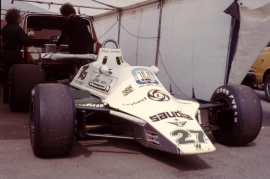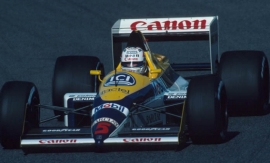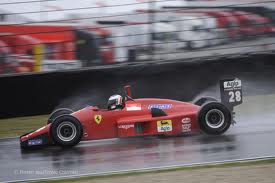To this day, there has only been one video game that has managed to get my slightly small body to queue up for its purchase on the day of release: F1 2012. Since buying that game nearly a year ago, no other game has been anywhere near the top of my playlist. Even with a small library of driving sims in my collection, not a single one has hit the spot quite like Codemasters’ 2012 game.
Now the next one lies around the corner, and it promises to be a magnum opus. It doesn’t come down to the improved physics engine or slightly sharpened graphics. New game modes are certainly welcome, but that’s not it either. I won’t even put it down to the fact that the game will follow in-season changes to the rules, such as changing the tire construction following the fiasco at the British Grand Prix earlier this year.
No, what it will come down to is the classics. Classic cars, classic drivers and classic tracks will be available to purchase with the “Classic Edition” of the game. Even the base comes with a grab-bag of goodies and offers the remaining content for download.
Why all the fuss? People who play driving simulators will tell you it’s about the experience–it’s meeting your heroes. Just like Forza 5 will be granting Xbox One owners the chance to “drive” cars they might not even get to see in real life, F1 2013 will be granting F1 fans the chance to drive bygone legends and modern machines. It is for the fans.
What classic cars and drivers are included you ask? Here’s a guide.
Williams FW07B – 1980. Regular Driver: Alan Jones; Legendary Driver: Alain Prost.
 The 1980 Williams FW07B was a car the pushed the boundaries of development to a new level. Powered by a 3.0 liter V8 Ford Cosworth DFV. It produced a respectable 500+ horsepower, but it’s real strength existed in its aero package. The car created additional grip with ground effects. With better handling than the competition and very strong drivers in 1980 champion Alan Jones and his teammate, Carlos Reutemann, the FW07B was Williams’ first crown jewel.
The 1980 Williams FW07B was a car the pushed the boundaries of development to a new level. Powered by a 3.0 liter V8 Ford Cosworth DFV. It produced a respectable 500+ horsepower, but it’s real strength existed in its aero package. The car created additional grip with ground effects. With better handling than the competition and very strong drivers in 1980 champion Alan Jones and his teammate, Carlos Reutemann, the FW07B was Williams’ first crown jewel.
Williams FW12 – 1988. Regular Driver: Nigel Mansell; Legendary Driver: Damon Hill.
 A car of what could have been great, the FW12 was ruined by the miserable Judd CV 3.5 liter V8. Whereas the Honda turbos of the era were thrashing out over 1000hp, the Judd puffed along with 600hp. That was before the reactive suspension system leeched power and only when the engine wasn’t busy being broken. Eventually the team decided to strip the reactive suspension out of the car and revise its aerodynamics. It took some time but eventually the FW12 saw success, with Mansell taking two second places. He might have scored more points, but the reliability was so poor that those two podiums coincided with his only two race finishes of the year.
A car of what could have been great, the FW12 was ruined by the miserable Judd CV 3.5 liter V8. Whereas the Honda turbos of the era were thrashing out over 1000hp, the Judd puffed along with 600hp. That was before the reactive suspension system leeched power and only when the engine wasn’t busy being broken. Eventually the team decided to strip the reactive suspension out of the car and revise its aerodynamics. It took some time but eventually the FW12 saw success, with Mansell taking two second places. He might have scored more points, but the reliability was so poor that those two podiums coincided with his only two race finishes of the year.
Williams FW14B – 1992. Regular Driver: Nigel Mansell; Legendary Driver: David Coulthard.
 It could be argued that no car before or since the FW14B has demonstrated technological prowess to such a mind-boggling degree. This is a car that boasted the most refined semi-automatic gearbox Formula 1 had seen at the time, and it also was in possession the most advanced and complex reactive suspension system. Top that off with advanced aerodynamics and a 3.5 liter Renault V10 that put out 900hp (more power anything else in the field) and it’s easy to see how this car won 10 of 16 races in the 1992 season–nine of those coming from Mansell alone.
It could be argued that no car before or since the FW14B has demonstrated technological prowess to such a mind-boggling degree. This is a car that boasted the most refined semi-automatic gearbox Formula 1 had seen at the time, and it also was in possession the most advanced and complex reactive suspension system. Top that off with advanced aerodynamics and a 3.5 liter Renault V10 that put out 900hp (more power anything else in the field) and it’s easy to see how this car won 10 of 16 races in the 1992 season–nine of those coming from Mansell alone.
Williams FW18 – 1996. Regular Driver: Damon Hill; Legendary Driver: Jacques Villeneuve.
 One of the most successful Formula 1 cars of all time, the FW18 was a supremely rounded package. It boasted excellent power with its 3.0 liter Renault V10, had excellent mechanical grip and spectacular downforce. The end result was that year’s champion, Damon Hill, winning 8 of 16 races, and rookie teammate, Jacues Villeneuve, finishing runner up with four victories. On top of winning 12 of 16 races, the car further demonstrated its dominance by having both cars on the podium in every race but two.
One of the most successful Formula 1 cars of all time, the FW18 was a supremely rounded package. It boasted excellent power with its 3.0 liter Renault V10, had excellent mechanical grip and spectacular downforce. The end result was that year’s champion, Damon Hill, winning 8 of 16 races, and rookie teammate, Jacues Villeneuve, finishing runner up with four victories. On top of winning 12 of 16 races, the car further demonstrated its dominance by having both cars on the podium in every race but two.
Williams FW21 – 1999: Regular Driver: ; Legendary Driver: .
Team Lotus 98T – 1986. Regular Driver: Mario Andretti; Legendary Driver: Emerson Fittipaldi.
Powered by a turbocharged 1.5 liter V6 capable of putting out up to 1200 to 1300 horsepower, the Lotus was extremely competitive. In the hands of the late great Ayrton Senna (Andretti was selected as the driver for licensing reasons) the car won two races, four second places and two thirds, helping Ayrton to finish the season an impressive fourth with nearly 20 times the points scored by his teammate. With better reliability, Ayrton might have taken his first championship with the car.
Team Lotus 100T – 1988. Regular Driver: Satoru Nakajima; Legendary Driver: Mika Hakkinen.
 Though not the highlight of Team Lotus’ efforts, the 100T does get honorable mention for being the only car in the game to feature the 1.5 liter Honda turbo V6–even if it is the one that was restricted to 2.5 Bar. Making do with 650+ horsepower (over 350 down from the previous year’s Hondas), the 100T was a solid best-of-the-rest car in a year when McLaren Honda had unheard of dominance. Nelson Piquet was the team’s workhorse, providing all the third place podiums and 21 of the team’s 22 points. His teammate, Nakajima, was so slow that he failed to qualify twice.
Though not the highlight of Team Lotus’ efforts, the 100T does get honorable mention for being the only car in the game to feature the 1.5 liter Honda turbo V6–even if it is the one that was restricted to 2.5 Bar. Making do with 650+ horsepower (over 350 down from the previous year’s Hondas), the 100T was a solid best-of-the-rest car in a year when McLaren Honda had unheard of dominance. Nelson Piquet was the team’s workhorse, providing all the third place podiums and 21 of the team’s 22 points. His teammate, Nakajima, was so slow that he failed to qualify twice.
Ferrari F1/87/88C – 1988. Regular Driver: Gerhard Berger; Legendary Driver: Michael Schumacher.
 In the face of McLaren’s 1988 dominance, the mettle of this Ferrari is easily sold short. But this evolution of the two race winning 1987 version might have been the second best car of the year. With seven pieces of bronze and silver to the credit of both its drivers, the F1/87/88C also holds the distinction of being the only non-McLaren car to take a win in 1988–courtesy of Gerhard Berger. Even though the win came down to luck, the tifosi were delighted, as Michele Alboreto piloted the sister car to second place, giving a Ferrari 1-2 in Italy.
In the face of McLaren’s 1988 dominance, the mettle of this Ferrari is easily sold short. But this evolution of the two race winning 1987 version might have been the second best car of the year. With seven pieces of bronze and silver to the credit of both its drivers, the F1/87/88C also holds the distinction of being the only non-McLaren car to take a win in 1988–courtesy of Gerhard Berger. Even though the win came down to luck, the tifosi were delighted, as Michele Alboreto piloted the sister car to second place, giving a Ferrari 1-2 in Italy.
Ferrari F92A – 1992. Regular Driver: Jean Alesi. Legendary Driver: TBA
 By no means Ferrari’s finest effort, the best part of the unreliable and less than outstanding F92A was Jean Alesi, it’s driver. Remarkable for being one of the V12s in the field, the F92A still didn’t have the oomph to compete with Williams, nor did it have the aerodynamics to match McLaren and Benetton. Late efforts to add active suspension didn’t pan out, and the semi-automatic transmission was too fragile. Somehow, Alesi managed to drive the car to two third places, helping the team finish 4th overall.
By no means Ferrari’s finest effort, the best part of the unreliable and less than outstanding F92A was Jean Alesi, it’s driver. Remarkable for being one of the V12s in the field, the F92A still didn’t have the oomph to compete with Williams, nor did it have the aerodynamics to match McLaren and Benetton. Late efforts to add active suspension didn’t pan out, and the semi-automatic transmission was too fragile. Somehow, Alesi managed to drive the car to two third places, helping the team finish 4th overall.
Ferrari F310 – 1996. Regular Driver: Michael Schumacher; Legend Driver: Gerhard Berger.
 A real turn around for Ferrari, this is a car that finally saw the prancing horse gallop back onto the podium. In the hands of Michael Schumacher, it was the biggest obstacle between Williams and a perfect season with the German claiming a total of 3 wins. Several other podiums helped the car claim a lonely second in the constructors’ cup. The basic design of the car was so capable that Ferrari used it as a guide to the cars that would bring them dominance from 2000 to 2004.
A real turn around for Ferrari, this is a car that finally saw the prancing horse gallop back onto the podium. In the hands of Michael Schumacher, it was the biggest obstacle between Williams and a perfect season with the German claiming a total of 3 wins. Several other podiums helped the car claim a lonely second in the constructors’ cup. The basic design of the car was so capable that Ferrari used it as a guide to the cars that would bring them dominance from 2000 to 2004.
Ferrari F399 – 1999. Regular Driver: Eddie Irvine; Legendary Driver: Jody Scheckter.
 Some might argue that this car would have won both the drivers’ championship and constructors’ championship if Michael Schumacher hadn’t injured himself in a bad accident that left him out of the cockpit for six races. Given how close his and teammate Eddie Irvine’s scores were at the time, it’s impossible to know for sure. As it is written, the F399 didn’t lead to a drivers’ championship, but it did give Ferrari their first constructor’s crown since 1983 and was the first chapter of their story of dominance.
Some might argue that this car would have won both the drivers’ championship and constructors’ championship if Michael Schumacher hadn’t injured himself in a bad accident that left him out of the cockpit for six races. Given how close his and teammate Eddie Irvine’s scores were at the time, it’s impossible to know for sure. As it is written, the F399 didn’t lead to a drivers’ championship, but it did give Ferrari their first constructor’s crown since 1983 and was the first chapter of their story of dominance.
As if that wasn’t good enough, the game will include classic tracks Estoril, Jerez, Imola and Brands Hatch–Estoril and Imola are Classic Edition exclusives. You can take the current 2013 spec cars to these grids and see how they compare next to the older stock, and the classics can be driven on modern circuits as well. All I would like to see are some classic McLaren cars and Ayrton Senna on the legends roster.
You can expect to see it hit shelves October 8 in North America, and October 4 in Europe. The base version and PC Classic can be pre-ordered, see Codemasters’ facebook for details.
